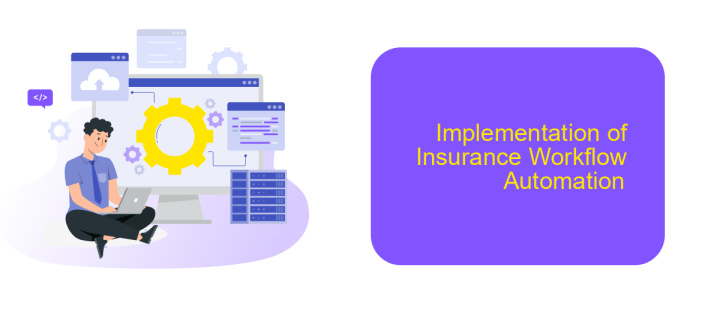Insurance Workflow Automation
In today's fast-paced insurance industry, workflow automation is revolutionizing how companies operate. By streamlining processes, reducing manual tasks, and enhancing efficiency, automation technologies are enabling insurers to deliver better customer service and improve overall productivity. This article explores the key benefits and implementation strategies of insurance workflow automation, highlighting its critical role in modernizing the sector.
Introduction
Insurance workflow automation is revolutionizing the insurance industry by streamlining processes, reducing manual tasks, and enhancing overall efficiency. With the advent of advanced technologies, insurers can now automate repetitive tasks, allowing them to focus on more strategic activities and improve customer satisfaction.
- Reduced operational costs
- Improved accuracy and compliance
- Enhanced customer experience
- Faster processing times
One of the key components in achieving seamless insurance workflow automation is the integration of various systems and services. Tools like ApiX-Drive facilitate these integrations by connecting different platforms and automating data transfer between them. This ensures that all systems work in harmony, providing a cohesive and efficient workflow. By leveraging such technologies, insurance companies can stay competitive and meet the evolving demands of the market.
Benefits of Insurance Workflow Automation

Insurance workflow automation offers numerous benefits that streamline operations and enhance efficiency. By automating repetitive tasks, insurers can significantly reduce manual errors, speed up claim processing, and improve customer satisfaction. This not only leads to cost savings but also frees up human resources to focus on more complex and value-added activities. Automation tools can handle everything from data entry to policy issuance, ensuring a seamless and error-free workflow.
Moreover, integrating various systems and software through platforms like ApiX-Drive further optimizes the insurance workflow. ApiX-Drive allows for seamless integration of multiple applications, enabling real-time data exchange and reducing the need for manual interventions. This leads to better data accuracy and consistency across different systems, enhancing decision-making and operational efficiency. In summary, insurance workflow automation, supported by robust integration tools, transforms traditional processes into agile and efficient operations, driving growth and customer satisfaction.
Key Features of Insurance Workflow Automation

Insurance workflow automation significantly enhances the efficiency and accuracy of insurance processes. By automating repetitive tasks, insurance companies can focus on more complex and value-added activities, ultimately improving customer satisfaction and operational performance.
- Streamlined Claims Processing: Automation speeds up the claims process by automatically verifying data, assessing damage, and approving claims, reducing the turnaround time significantly.
- Policy Management: Automated systems handle policy renewals, updates, and cancellations, ensuring that all changes are processed accurately and promptly.
- Customer Communication: Automation facilitates timely and personalized communication with clients through automated emails, notifications, and chatbots.
- Data Integration: Tools like ApiX-Drive enable seamless integration of various data sources and systems, ensuring that all relevant information is accessible in one place.
- Regulatory Compliance: Automated workflows ensure that all processes adhere to regulatory requirements, minimizing the risk of non-compliance.
By leveraging these key features, insurance companies can not only reduce operational costs but also provide a superior customer experience. Automation tools like ApiX-Drive play a crucial role in integrating various systems, thereby enhancing the overall efficiency of insurance workflows.
Implementation of Insurance Workflow Automation

Implementing insurance workflow automation involves a comprehensive approach to streamline and optimize various processes within the insurance industry. The first step is to identify the key areas where automation can deliver the most value, such as claims processing, underwriting, and customer service. By focusing on these critical functions, insurance companies can significantly enhance efficiency and reduce operational costs.
Once the target areas are identified, the next step is to select the appropriate automation tools and technologies. One effective solution is ApiX-Drive, a service that facilitates seamless integration between various software applications. ApiX-Drive allows insurance companies to automate data transfer, synchronize information across different platforms, and eliminate manual data entry, thereby minimizing errors and saving time.
- Identify key areas for automation (claims processing, underwriting, customer service)
- Select appropriate automation tools and technologies
- Utilize integration services like ApiX-Drive for seamless data transfer
- Implement and monitor automated workflows for continuous improvement
After implementing the chosen tools and technologies, it is crucial to continuously monitor and evaluate the performance of the automated workflows. Regular assessments help in identifying any bottlenecks or areas for further improvement, ensuring that the automation processes remain efficient and effective over time. By adopting a strategic and methodical approach, insurance companies can fully leverage the benefits of workflow automation.
Best Practices for Insurance Workflow Automation
Implementing insurance workflow automation requires a strategic approach to ensure efficiency and accuracy. Begin with a comprehensive assessment of current workflows to identify bottlenecks and areas for improvement. Prioritize tasks that are repetitive and time-consuming, as these are prime candidates for automation. It's crucial to involve stakeholders from different departments to gather insights and ensure the automation solutions meet diverse needs. Additionally, maintaining clear documentation of all processes and changes will facilitate smoother transitions and ongoing management.
Integration is key to successful automation. Utilize services like ApiX-Drive to seamlessly connect various software and platforms, ensuring data flows effortlessly between systems. This not only reduces manual data entry but also minimizes errors, enhancing overall productivity. Regularly review and update automated workflows to adapt to changing business requirements and regulatory standards. Finally, invest in training for employees to ensure they are proficient with new tools and processes, fostering a culture of continuous improvement and innovation.
- Automate the work of an online store or landing
- Empower through integration
- Don't spend money on programmers and integrators
- Save time by automating routine tasks
FAQ
What is Insurance Workflow Automation?
How can Insurance Workflow Automation benefit my insurance business?
What types of tasks can be automated in an insurance workflow?
How do I integrate automation tools into my existing insurance systems?
Is it difficult to implement Insurance Workflow Automation in my company?
Routine tasks take a lot of time from employees? Do they burn out, do not have enough working day for the main duties and important things? Do you understand that the only way out of this situation in modern realities is automation? Try Apix-Drive for free and make sure that the online connector in 5 minutes of setting up integration will remove a significant part of the routine from your life and free up time for you and your employees.


